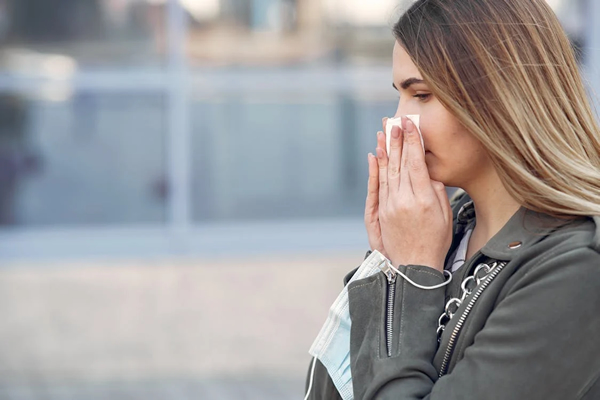All About Hay Fever: Symptoms, Causes, and Tips for Relief
2024 November 25
For many, the warmer months bring along a not-so-welcome guest: hay fever. This common condition can make outdoor activities a struggle, as sneezing, itching, and watery eyes become an almost daily experience. In this blog, we’ll explore what hay fever is, its symptoms, causes, and effective strategies to help manage it so you can enjoy each season.
What is Hay Fever?
Also known as allergic rhinitis, hay fever is an allergic response to airborne particles, such as pollen, dust, and pet dander. These particles, or allergens, trigger an immune response in susceptible individuals, leading to a variety of uncomfortable symptoms. Unlike a cold, hay fever isn’t caused by a virus; instead, it’s the immune system’s reaction to what it mistakenly identifies as a threat.

Common Symptoms of Hay Fever
Hay fever symptoms can range from mild to severe and typically include:
- Sneezing: Often one of the first symptoms, sneezing is the body’s way of expelling allergens from the nasal passages.
- Runny or Stuffy Nose: Mucus production increases, resulting in a runny nose or, alternatively, nasal congestion.
- Itchy Eyes, Nose, or Throat: Histamine release causes itching, particularly in the eyes and nose, which can be quite bothersome.
- Watery Eyes: This condition can cause the eyes to become red, watery, and light sensitive.
- Fatigue and Headaches: Severe allergies can lead to fatigue and even mild headaches due to constant sneezing and nasal congestion.
In addition to these symptoms, some individuals may also experience mild skin reactions or feel unusually worn out due to disrupted sleep.
What Causes Hay Fever?
The immune system overreacts to allergens, typically inhaled particles, causing hay fever. When these allergens contact the lining of the nose, eyes, or throat, the body releases histamines and other chemicals to fight off what it perceives as a threat. This release triggers the classic hay fever symptoms. Common hay fever triggers include:
- Pollen: Grass, tree, and weed pollen are some of the most prevalent causes, especially during the spring and summer months.
- Dust Mites: Tiny insects found in household dust can trigger symptoms year-round, especially in indoor settings.
- Pet Dander: Proteins found in animal skin flakes, saliva, and urine can cause allergic reactions in many people.
- Mould Spores: Mould thrives in damp environments, and inhaling its spores can lead to hay fever symptoms.
- Air Pollution: Smoke, smog, and chemicals in the air can irritate the nasal passages and worsen hay fever symptoms.
Seasonal vs. Perennial Hay Fever
Depending on the triggers, hay fever can be either seasonal or perennial (year-round).
- Seasonal Hay Fever: Typically occurs during specific times of the year when certain pollens are more prevalent. For instance, spring brings tree pollen, summer brings grass pollen, and autumn brings weed pollen.
- Perennial Hay Fever: Affects individuals throughout the year with triggers like dust mites, pet dander, and mould.
Managing Hayfever symptoms
While there is no cure for hay fever, there are several strategies that can help reduce symptoms and enhance comfort:
- Avoiding Triggers: Limiting exposure to allergens is key. Check pollen counts daily, and if they’re high, consider staying indoors or wearing a mask outside.
- Over-the-Counter (OTC) Medicines: Antihistamines like loratadine, cetirizine, or fexofenadine can help manage sneezing, itching, and runny nose. Nasal sprays and eye drops may also be effective for localised symptoms.
- Allergy-Proofing Your Home: Use dust-mite covers on bedding, vacuum regularly, and maintain low indoor humidity to reduce dust and mould.
- Nasal Irrigation: Rinsing your nasal passages with a saline solution can help clear out allergens and reduce congestion.
- Close Windows and Doors: During peak pollen seasons, keeping windows closed can help prevent pollen from entering your home.
- Wearing Sunglasses: Wearing sunglasses can help protect your eyes from airborne allergens when you’re outdoors.

When to see a doctor
OTC remedies and lifestyle changes often manage hay fever, but sometimes the symptoms persist or worsen. If you find that your symptoms are interfering significantly with your daily life or you experience complications like sinus infections, it may be time to consult a healthcare provider. They may recommend prescription medications, allergy shots, or other treatments.
Understanding the symptoms and causes of hay fever along with strategies for symptom relief can significantly improve your outdoor enjoyment. With a proactive approach and the right combination of lifestyle adjustments and medications, you can minimise the impact of hay fever and get back to enjoying the seasons.
Time to take action
If you’re struggling with persistent hay fever symptoms, consider discussing treatment options with a healthcare provider to find relief tailored to your needs. With the right support, you can keep your allergies under control and fully enjoy life.

